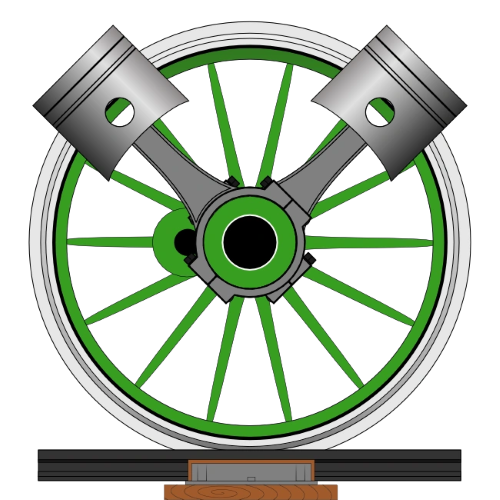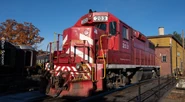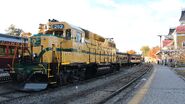The EMD; Electro Motive Division, GP38 is a four-axle type of 2,000 hp diesel locomotive built from 1966 to 1971. As of 2013, many of these locomotives are still running, either in their original form or rebuilt to different specifications.
In total 733 units were produced, yet originals are rare due to rebuilding and upgrading.
History[]
The GP38 was one of a many models introduced in 1966 with the development of the EMD 645-series engine. It used a Roots-blown 16-cylinder version of the engine and was built alongside the GP40 (which included a turbocharged 16-cylinder engine) and the GP39 (with a turbocharged 12-cylinder engine; literally being the turbocharged version of the GP38). The SD38, SD39, SD40 and SD45 were contemporary six-axle models of the series (having 645-series engines).
The GP38 retained the traditional Roots blower used in EMD's first-generation diesel engines (units equipped with 567-series engine; such as the F7 and GP7), which had largely lost popularity against turbocharged variants. Its predecessor; the GP28, was heavily outsold by the concurrent GP35. However, the versatility of the GP38 combined with expensive turbocharger maintenance on higher-powered units made it a sales success, with 706 produced for US railroads. In service, the success of the GP38 spurred substantially higher sales of the later GP38-2, which ultimately replaced the GP38 in 1972 when EMD released their Dash 2 line of locomotives.
Although intended for high-speed, heavy-duty freight service; the GP38 was primarily used for short branchline trains, as well as for slow goods (or manifest freight) service, and yard service.
Most railroads (mainly shortlines and other companies) still primarily use their GP38 units (and counter-part models) for such services today.
Specifications[]
The GP38 was 59' 2" long, weighed a nominal 245,000 lb (subject to railroad specifications) and developed 50,000 lbs of continuous tractive effort at 10.8 mph. Power was provided by a 2,000 horsepower, 16-cylinder 645E engine connected to a DC generator supplying four DC traction motors. The GP38AC, a variant of the GP38 (introduced later in the production run), adopted the alternator-rectifier system used in the GP40 in which the AC current from the alternator was rectified to DC to power the traction motors. Dynamic brakes were optional, but present on much of the production total.
Compared to other EMD models built concurrently, the GP38 can be identified by a B-B (four-axle) wheel arrangement, two central exhaust stacks, two somewhat widely spaced 48" radiator fans at the rear of the hood, a 1-2-4 door arrangement under the radiator intakes, and a panel between the radiators and the power assembly doors which was not present on the GP28.
Related Models[]
The SD38 (produced concurrently), was a six-axle version of the GP38, but comparatively few were produced. The GP39 and GP40 used different prime movers (12- and 16-cylinder turbocharged, respectively from the EMD 645 series engine) but were otherwise very similar mechanically and visually to the GP38.
By the 1990s, some units were rebuilt into GP38-2 specifications. Some were also converted to road slugs by several railroads (such as BNSF and CSX), often powered by modified GP40-2 or GP40-3 units (mated to the slug units).
Trivia[]
The NECR (New England Central Railway) is one of the only other modern railroads to still actually own a fleet of true, non-rebuilt/non-modified GP38 units (with the exception of having a fleet of "Dash 2" units purchased much later).
The Spokane, Portland and Seattle Railway (SP&S) ordered six GP38 units, but they were received in February 1970, after the Burlington Northern merger.





